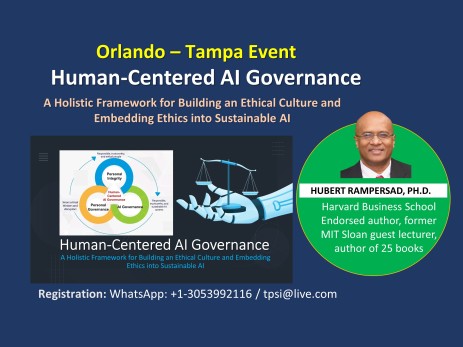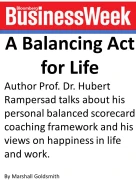Hubert Rampersad, Ph.D.
We need a new generation of brilliant engineers with a new mindset to design a better world and create a vibrant future. Engineering colleges and universities today do not commonly teach the skills that future engineers will need. Engineers must possess skills like creativity, imagination, agility, critical thinking, and sustainability to become visionary and innovative entrepreneurial leaders or to design innovative products. These skills are not typically associated with engineering, but the rapid rate of technological change has made most college and university courses obsolete by the time students graduate. STEM programs give engineers insights into science, technology, engineering, and mathematics. However, they often fail to nurture the holistic, authentic, and imaginative qualities essential for tomorrow’s engineers. Read “How STEM Education is Failing in the Age of AI.”
This article is based on my experience as a senior design innovation coach at ASML, the world’s most essential and Europe’s most valuable tech firm. It is also the only tech company in the world with a design-driven culture.
Many US and European tech companies struggle to find qualified creative and imaginative engineers with sustainability skills to fill critical engineering and technology jobs. This is a concerning trend, as these engineers play a crucial role in shaping our future and developing new technologies to help us address some of the world’s most pressing challenges. The pandemic has taught us valuable lessons about the importance of sustainability and the need to design a better world. As we move forward, we must prioritize sustainability and work towards creating a more equitable and sustainable future for all. This article provides a unique method to address these challenges.
We need to foster a new future generation of technically proficient engineers who are creative, imaginative, and focused on sustainability, with a resilient, agile mindset. Sustainability is a critical concept that guides the design of a better world, as it means meeting the needs of the present without compromising the ability of future generations to meet their own needs. “Sustainability involves a holistic and ethical approach that aims to establish a harmonious coexistence between humans and nature for an extended period.”-– Hubert Rampersad. Read “10 Ways to Kill Creativity, Sustainability, and Innovation”.
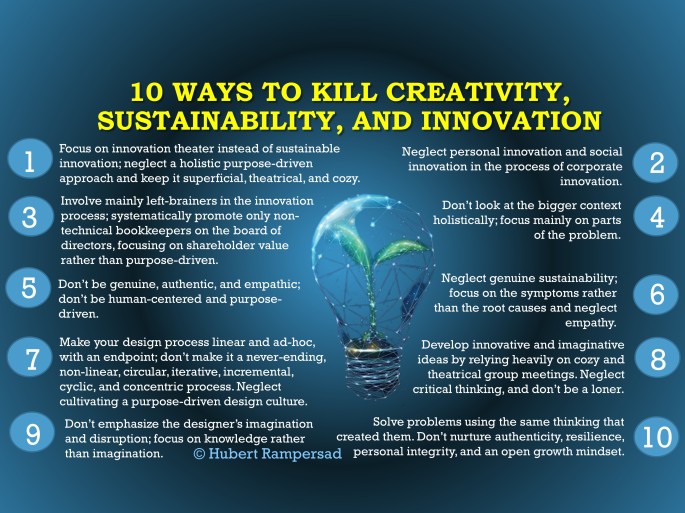
Right-brained thinking, associated with sustainability, imagination, intuition, and emotion, is considered an essential skill for modern executives. Therefore, we must encourage and nurture right-brained thinking in our engineers, especially regarding sustainability. This involves authenticity, integrity, agility, empathy, and critical thinking. By doing so, innovative engineers can create a more sustainable and equitable future for all. Read my article “Sam Altman Shows What Genuine Empathetic Leadership Is.”
Eco-Design Thinking
Read my article “The End of Design Thinking: Cultivating a Purpose-Driven Design Culture to Fix the World.” We must adopt a new design method and way of thinking to design a better world. As Einstein famously stated, “We cannot solve our problems with the same thinking we used when we created them.” That’s where eco-design thinking emerges, shifting from the traditional fixed mindset to a more dynamic growth mindset. The difference between these two approaches is illustrated in the figure below.

Engineers who favor their brain’s left side and ignore the right lack balance, limiting their ability to approach complex design issues holistically and creatively. This leads to bad designs. Read “ Why Creativity Sucks“.
Why Creativity Sucks“.
Bad Designs
My article “Top-10 Causes of Bad Designs” highlights the negative impact of bad designs due to a lack of the skills mentioned above. Some examples of failed sustainable engineering projects that should have demonstrated the use of the right brain and creative and imaginative skills but failed are the $2 trillion F-35 project, the Boeing 737 Max airplane, the T-14 Armata Russian Tank, and the Samsung. Galaxy Note 7. Please take the time to read my article “Why OceanGate’s Design Approach Sucks; How the Doomed Titan Sub Tragedy Could Have Been Avoided.” CEOs who prioritize their personal design choices over critical safety regulations, endangering human lives, can learn a valuable lesson from the tragedy of the Titan. This also applies to individuals like Elon Musk and companies like Boeing. Elon Musk’s $3 billion Mars rocket failure could have also been avoided. The following figure displays the top 10 reasons for bad designs due to the lack of the skills mentioned above engineers should have.
Galaxy Note 7. Please take the time to read my article “Why OceanGate’s Design Approach Sucks; How the Doomed Titan Sub Tragedy Could Have Been Avoided.” CEOs who prioritize their personal design choices over critical safety regulations, endangering human lives, can learn a valuable lesson from the tragedy of the Titan. This also applies to individuals like Elon Musk and companies like Boeing. Elon Musk’s $3 billion Mars rocket failure could have also been avoided. The following figure displays the top 10 reasons for bad designs due to the lack of the skills mentioned above engineers should have.
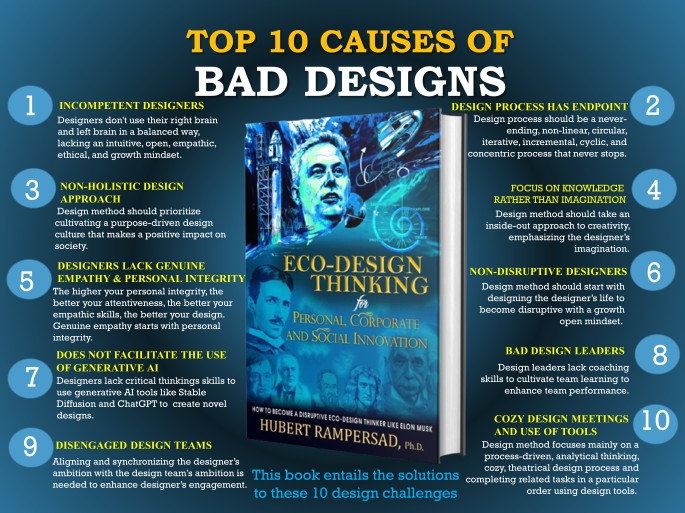
New Design Method
Better and brighter engineers are not enough to design a better world. We must adopt a new design method better suited for generative AI to develop a more sustainable world. This method should prioritize creating intelligent, resilient, empathetic, and honest designers. To achieve this goal, I have introduced eco-design thinking. This creative process involves empathizing with yourself, the end user, and the environment to generate innovative, imaginative, empathetic, and disruptive design ideas. The new model is depicted in the figure below and consists of four stages: Explore, Ideate, Prototype, and Execute. It is an iterative, incremental, cyclic, and concentric process of exploring, ideating, prototyping, and executing (Rampersad, 2022). AI-powered tools that generate content can be helpful in every stage of the design process. Eco-design thinking is a circular and iterative process that has no endpoint. The model consists of various stages that may form iterative loops and do not need to follow a specific sequence. Every iteration brings forth fresh insights. It is recommended that this process be repeated until the issues of the designer and end-user reach an acceptable level. Eco-design thinking is a continuous and circular process that requires testing and refining your design while empathizing with yourself, the users, and the environment. At any design stage, generative AI tools can produce the best empathic design customized to the end-user’s needs and the environment. Read my article “How SDGs, ESG, and Purpose Fuel Design For Sustainability” to learn more about this new design method.
Eco-design thinking is a circular and iterative process that has no endpoint. The model consists of various stages that may form iterative loops and do not need to follow a specific sequence. Every iteration brings forth fresh insights. It is recommended that this process be repeated until the issues of the designer and end-user reach an acceptable level. Eco-design thinking is a continuous and circular process that requires testing and refining your design while empathizing with yourself, the users, and the environment. At any design stage, generative AI tools can produce the best empathic design customized to the end-user’s needs and the environment. Read my article “How SDGs, ESG, and Purpose Fuel Design For Sustainability” to learn more about this new design method.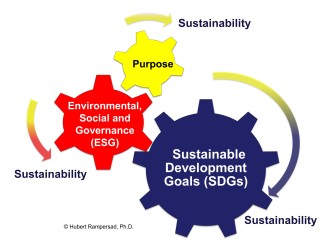
Generative AI
Generative AI offers engineers a unique approach to optimizing design processes. We are experiencing rapid innovation in AI and automation, which is expected to significantly impact the future of jobs and productivity. The emergence of generative AI has brought about significant changes across various fields, including innovation and revolutionizing manufacturing processes and engineering. All this underscores the importance of reskilling and the need to address talent shortages to prepare engineers for labor market shifts. Organizations must invest in training and upskilling programs to ensure engineers have the necessary creativity, innovation, imagination, critical thinking, and resilience skills to thrive in the AI-driven age. Engineers are overwhelmed with information in this age and struggle to think deeply and reflectively. Therefore, critical thinking has become more important for engineers than ever when dealing with AI. Engineers must be able to question AI-generated results, recognize possible limitations in the underlying data, and be aware of potential biases in the AI algorithms.
Critical Thinking
Critical thinking is evaluating and analyzing information to make well-informed decisions and judgments. By using critical thinking, engineers can improve their ability to effectively communicate, solve problems, build arguments, and Conclude effectively. Isaac Newton discovered gravity using his critical thinking skills. Millions saw the apple fall, but only Isaac Newton asked WHY. He wondered why the apple fell straight down rather than sideways or upward. This inspired him to eventually develop his law of universal gravitation.
Conclude effectively. Isaac Newton discovered gravity using his critical thinking skills. Millions saw the apple fall, but only Isaac Newton asked WHY. He wondered why the apple fell straight down rather than sideways or upward. This inspired him to eventually develop his law of universal gravitation.
Personal Disruptive Innovation for Cultivating a New Generation of Engineers
Personal disruptive innovation is a new holistic system for developing human intelligence, empathy, integrity, and critical thinking.  This will help engineers generate more imaginative, innovative, empathetic, and disruptive ideas. This article explores the concept of personal disruptive innovation, based on my latest book, “Eco-Design Thinking for Personal, Corporate, and Social Innovation.” Read my article “The End of Design Thinking: Cultivating a Purpose-Driven Design Culture to Fix the World.”
This will help engineers generate more imaginative, innovative, empathetic, and disruptive ideas. This article explores the concept of personal disruptive innovation, based on my latest book, “Eco-Design Thinking for Personal, Corporate, and Social Innovation.” Read my article “The End of Design Thinking: Cultivating a Purpose-Driven Design Culture to Fix the World.”
Engineers must redesign themselves to become empathic and disruptive critical thinkers. Personal disruptive innovation is an approach that will unlock their creative potential and allow them to make a meaningful impact on society. They can break free from conventional thinking and expand their horizons by embracing innovation. In this way, they will not think outside the box; they will think like there is no box. This approach will also help them to become more resilient and ethical. Personal disruptive innovation is a part of my holistic eco-innovation model, shown below. Read “The Future of Innovation”.
The Ultimate Critical Thinking Roadmap For Engineers
Personal disruptive innovation is the authenticity, integrity, empathy, and critical thinking roadmap that will help you unlock your creative potential by cultivating a solid growth, ethical and critical thinking mindset, creating new and unique opportunities, and disrupting current systems. It will help you build a resilient and agile mindset, a way of thinking that emphasizes flexibility, adaptability, and collaboration. The personal disruptive innovation model involves five steps that cultivate authenticity, integrity, empathy, and critical thinking: 1. Personal Ambition, 2. Personal Brand, 3. Personal Innovation Strategy, 4. Implementation, and 5. Personal Integrity & Empathy. This model is illustrated below:

The key in this model is to develop self-knowledge to drive personal innovation, which will help engineers unleash their creative potential and imagination, become more resilient and authentic, and sharpen their authenticity, integrity, empathy, and critical thinking skills. Without self-knowledge, engineers won’t be able to succeed as empathetic and disruptive innovators. This will guide their beliefs and actions, helping them discover their purpose in life and leading them to a more fulfilling, content, and healthier life, personally and professionally. It enables them to define their higher calling, become a visionary, and discover their life’s purpose. Elon Musk once said: “Attach yourself to a mission, a calling, a purpose only. That’s how you keep power and your peace. It worked pretty well for me this far”.
The personal disruptive innovation model consists of the following five phases:
1. Personal Ambition: The initial step involves engaging in a reflective process that includes deep thinking, introspection, and self-reflection. During this phase, you’ll be introduced to breathing and silence exercises that will aid in developing self-awareness. Self-knowledge is the ultimate goal of this phase. The outcome of this phase will be the creation of your personal mission, vision, and key roles, as illustrated in the diagram below. Remember what Elon Musk said: “Don’t even attach yourself to a person, a place, a company, an organization, or a project. Attach yourself to a mission, a calling, a purpose only. That’s how you keep power and your peace. It worked pretty well for me this far”. Through this process, you’ll gain insights into your life and acquire self-knowledge, self-awareness, and self-regulation, which are the building blocks of authenticity, empathy, trustworthiness, integrity, creativity, imagination, and critical thinking. Your personal ambition statement also serves as the foundation of an innovative, creative, imaginative mindset. The figure below shows the personal ambition framework. Ask yourself these questions and answer them honestly.
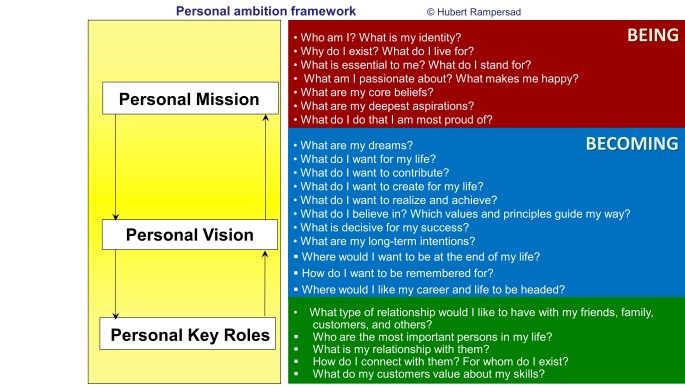
By practicing breathing and silence exercises, you can better connect with your inner self and find answers to these questions. This will help you to discover your higher purpose. Through this process, you’ll cultivate self-knowledge, self-awareness, self-management, and self-learning, which entails a journey toward personal disruptive innovation, as shown in this diagram:

The best ideas come when you are alone. Self-learning – the ability to gather, process, retain, and evaluate knowledge alone — is the foundation of creativity and imagination. Traditional creativity approaches lack imagination because they neglect self-learning and, because of this, fail to address complex problems. They heavily rely on group meetings and, therefore, miss opportunities to develop innovative and imaginative ideas. Nikola Tesla developed many creative ideas while working alone for over thirty years. Similarly, Stephen Hawking made significant discoveries while confined to his wheelchair, and Isaac Newton famously discovered gravity while in social isolation. Remember Nikola Tesla’s statement: “Being alone is when ideas are born. This is the secret of innovation”. Albert Einstein said almost the same: “Albert Einstein said almost the same: “Be a loner. That gives you time to wonder, to search for the truth. Have holy curiosity. Make your life worth living”.
Remember Nikola Tesla’s statement: “Being alone is when ideas are born. This is the secret of innovation”. Albert Einstein said almost the same: “Albert Einstein said almost the same: “Be a loner. That gives you time to wonder, to search for the truth. Have holy curiosity. Make your life worth living”.
Spirituality can play a vital role in eco-design thinking and innovation. It provides the intuition needed to make tough decisions and develop a higher level of consciousness. Elon Musk once said, “We should aspire to increase the scope and scale of human consciousness to understand better what questions to ask. The only thing that makes sense It is to strive for greater collective enlightenment.” By focusing inwardly and reflecting on your actions through self-examination with breathing and silence exercises, you can gain insights about yourself and your life’s purpose. This is what Einstein wanted to know.
It is to strive for greater collective enlightenment.” By focusing inwardly and reflecting on your actions through self-examination with breathing and silence exercises, you can gain insights about yourself and your life’s purpose. This is what Einstein wanted to know.
You will also find out why you were born. This process will help you learn more about yourself and discover the truth about your life’s purpose. As Thomas Huxley said, “Learn what is true to do what is right.” This process enables you to learn more and discover the truth about yourself. By formulating personal ambition, you can initiate self-examination and prepare your mindset for critical thinking. As you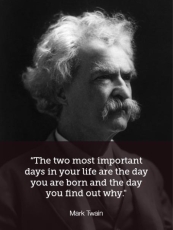 become more conscious of yourself, gain more creativity, and become a critical thinker. The thinking process and mindset changes are meant to prepare you for action as a proactive, empathic, and ethical critical thinker. Based on insights acquired through this process, you will also become more self-assured and work smarter through self-learning and self-knowledge. You become more creative and innovative as you grow more conscious of yourself. The words of Galileo Galilei may also be
become more conscious of yourself, gain more creativity, and become a critical thinker. The thinking process and mindset changes are meant to prepare you for action as a proactive, empathic, and ethical critical thinker. Based on insights acquired through this process, you will also become more self-assured and work smarter through self-learning and self-knowledge. You become more creative and innovative as you grow more conscious of yourself. The words of Galileo Galilei may also be recalled here—“You cannot teach a man anything; you can only help him discover it in himself.” Remember, the more you want to be innovative, the more you should develop self-knowledge. Read “How Mindful Meditation Boosts Critical Thinking in the Age of AI.”
recalled here—“You cannot teach a man anything; you can only help him discover it in himself.” Remember, the more you want to be innovative, the more you should develop self-knowledge. Read “How Mindful Meditation Boosts Critical Thinking in the Age of AI.”
By practicing breathing and silence exercises, you can better connect with your inner voice and find answers to the questions you seek. This requires tuning into the same wavelength as your spirit, which is closely linked to the concept of synchronicity. Synchronicity refers to meaningful coincidences or events that co-occur without apparent. It is the connection between the ‘inner world’ and the ‘outer world’; consciousness bridges these two dimensions. Synchronicity can manifest in many ways, and it is a phenomenon studied by psychologists such as Carl Gustav Jung and Nikola Tesla, who were also in sync with the universe. I also act like a receiver and tune in at the same frequency.
It is the connection between the ‘inner world’ and the ‘outer world’; consciousness bridges these two dimensions. Synchronicity can manifest in many ways, and it is a phenomenon studied by psychologists such as Carl Gustav Jung and Nikola Tesla, who were also in sync with the universe. I also act like a receiver and tune in at the same frequency.
Your personal ambition comprises your mission, vision, and key roles. You can click on this link to view my personal ambition statement. Having a clear purpose is crucial to becoming a visionary. According to Elon Musk, the thing that drives him is vision. He said, “I think having an inspiring and appealing future is important. There must be reasons you get up in the morning and want to live. Why do you want to live? What’s the point? What inspires you? What do you love about the future?” Elon Musk’s vision is to create an inspiring and appealing future for humanity.
2. Personal Brand: In this phase, engineers will define and formulate an authentic personal brand promise that will be the focal point of their storytelling throughout each stage of my new proposed design process. Read “Crafting Your Authentic Personal Brand: A 5-Step Guide”. Storytelling is an essential tool that can be used to engage with customers at different stages of the design process. Take the time to create your brand statement, ensuring it aligns with your ambition. Then, craft a compelling brand story to promote the brand called “You.” Elon Musk is an excellent example of a powerful personal brand and a brilliant storyteller. He emotionally connects with his audience by sharing his vision and passion for innovation. This figure shows the seven steps to develop your authentic personal brand. Following these steps, engineers can create a personal brand that reflects their values, strengths, and aspirations and will help them stand out in a crowded market. Please click on this link to view my personal brand statement. 
3. Personal innovation strategy: To bring your personal ambition to life, it’s crucial to act. This means creating a personal innovation strategy based on your mission, vision, and key roles. A personal innovation strategy includes a roadmap to help you develop a stronger mindset and authenticity, integrity, empathy, and critical thinking skills. Without continuous improvement based on your personal innovation strategy, you won’t be able to develop intelligent designs effectively, and this will not lead to your long-term growth and success. The following are the five steps to build your personal innovation strategy: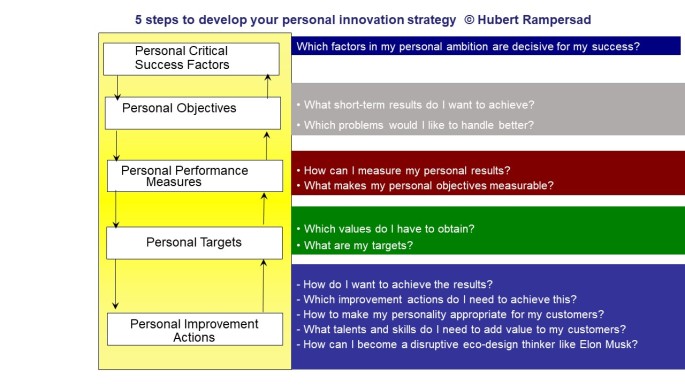
Your personal critical success factors are the key elements of your ambition and objectives. These factors are broken down into four perspectives: internal, external, knowledge and learning, and financial. Your personal innovation strategy helps you turn your personal ambition into manageable, measurable objectives and milestones in a balanced way. Using this strategy, you will effectively manage your time and become more innovative, creative, disciplined, proactive, imaginative, and empathetic. If you want to learn more about this personal innovation strategy system, I recommend reading my article “How to Redesign Your Life Based on Your Personal Innovation Strategy.” This article provides valuable insights on how to stay on track and avoid becoming obsolete. It’s an excellent resource for anyone who wants to become a disruptor like Elon Musk. Please click on this link to view my personal innovation strategy.
“How to Redesign Your Life Based on Your Personal Innovation Strategy.” This article provides valuable insights on how to stay on track and avoid becoming obsolete. It’s an excellent resource for anyone who wants to become a disruptor like Elon Musk. Please click on this link to view my personal innovation strategy.
4. Implementation: Once you have established your personal innovation strategy, it is essential to consistently implement, maintain, and cultivate it to effectively manage and challenge yourself in your personal and business life. To aid you in this process, I recommend following the PDAC cycle (Plan-Deploy-Act-Challenge), which is a continuous improvement cycle that will help your personal innovation strategy effectively, as illustrated in this diagram:

Implementing your personal innovation strategy through the PDAC cycle will lead to self-awareness, happiness, personal disruption, and enhanced authenticity, creativity, empathy, and critical thinking skills. It’s important to regularly update your personal innovation strategy and repeat the cycle to stay current with new challenges and lessons learned. These 50 tips will assist you in implementing your personal innovation strategy effectively.
strategy and repeat the cycle to stay current with new challenges and lessons learned. These 50 tips will assist you in implementing your personal innovation strategy effectively.
5. Personal integrity & empathy: Engineers must have personal integrity and empathy to effectively help design a better world. By demonstrating personal integrity, they will positively impact the quality of their designs and foster empathetic behavior. This figure illustrates this personal integrity concept:

Engineers must balance their personal ambition with their current behavior and actions to develop personal integrity and empathy. Finding a balance between personal ambition and actions is crucial to achieving sustained personal integrity and empathy. During this alignment process, it is essential to reflect honestly on the following questions: What are my personal values, and how do they align with my actions? How can I ensure that my actions are consistent with my values? What are the potential consequences of my actions toward others? How can I empathize with others and understand their perspectives? Am I staying true to my values and conscience in my actions? Are my thoughts and actions aligned consistently? How do my values and intentions relate to my current behavior? Is there congruity between my thoughts and my actions? Am I always acting according to my personal ambition and empathetic nature? Does my personal ambition reflect my desire to work with ethics and empathy? Are there any discrepancies between my personal ambition and my empathetic actions? Do I keep the promises I make to myself? How do others perceive me and my values? Do they see me as someone who stays true to my core beliefs and remains authentic to myself?
To enhance empathy and personal integrity, aligning your personal ambition with your behavior is essential. This involves achieving more excellent compatibility between the two elements so that they are in harmony, as shown below. When your personal ambition and behavior match, you will work authentically and purposefully toward designing a better world. This will lead to greater empathy, enhanced charisma, transparency, and trustworthiness. 
It is essential to ensure harmony between your personal ambition/brand and your actions to align your deeds with your conscience. Our conscience is the inner voice that guides us to distinguish between right and wrong, fact and fiction. By listening to this voice, we can gain better insight into our empathic behavior, strengths, and weaknesses, ultimately impacting our solidarity with others. Albert Schweitzer once said: “The first step in the evolution of ethics is a sense of solidarity and empathy with other human beings.”
Engineers must question themselves honestly: Have I always acted by my conscience? Have I always done what was right? Have I always acted morally as an AI user? Have I acted compassionately regularly?
Remember: The Titan Submarine tragedy was caused by the unethical behavior of CEO Stockton Rush, which resulted in the loss of both life and property. Similarly, the lack of integrity by Boeing’s leadership, which overlooked certain aspects of the Boeing 737 Max design to compete with their European competitor Airbus, led to the deaths of 346 individuals and was also a clear violation of ethical principles. They failed to have a Code of Ethics to ensure their engineers knew the moral standards they were expected to uphold. In my article titled “Why OceanGate’s Design Approach Sucks,” I highlight the significance of ethical considerations in design and engineering.
individuals and was also a clear violation of ethical principles. They failed to have a Code of Ethics to ensure their engineers knew the moral standards they were expected to uphold. In my article titled “Why OceanGate’s Design Approach Sucks,” I highlight the significance of ethical considerations in design and engineering.
Read also Building a Purpose-Driven Design Culture in Tech Companies
and “How to Restore the Higher Purpose of American Higher Education”.

To gain more knowledge about this subject, you may consider attending his Orlando-Tampa Live Events:
Building a Purpose-Driven Design Culture in Tech Companies
How Sustainability and Generative AI Fuel Design Innovation.
We also offer the Certified Authentic AI Leadership Coaching program. This program is appropriate for AI leaders, managers, and professionals who wish to strengthen their ethical leadership and critical thinking skills, drive their purpose and human-centeredness, and coach others to realize the same.
Hubert Rampersad, Ph.D., founded the Center of Excellence in Human-Centered and Purpose-Driven AI Innovation in Orlando. He is a Dutch-American visionary leader in innovative solutions for genuine sustainability, disruptive design innovation, critical thinking in the age of AI, human-centered and purpose-driven AI, and entrepreneurial leadership. He holds a Ph.D. in Innovation Sciences, an MSc in Technology Engineering & Robotics, and a BSc in Mechanical Engineering from leading accredited universities in the Netherlands (Delft University of Technology, Eindhoven University of Technology). He is a well-known futurist, advocating for genuine sustainability on a global scale. With extensive knowledge and expertise, he has authored 25 books on the topics above in many languages and is highly regarded for his insights in these fields. One of his books, “Total Performance Scorecard,” has been published in 20 languages. Dorothy Leonard, an innovation professor at Harvard Business School, wrote the book’s foreword. Rampersad has also previously served as a guest lecturer at MIT Sloan and was featured in BusinessWeek. He was a senior design innovation coach at ASML, the most crucial tech company in the world and “Europe’s most valuable tech firm“.

Orlando, Florida | tpsi@live.com | Phone/WhatsApp: +13053992116









